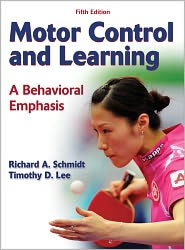MEDIA
REVIEW
media review written by Ted
Scheck
 If
this book is an introduction to the field of motor
control and learning, then I'm glad I only had to take Tests
& Measurements twice, because the math in there is similar
to the math in this text, which made my brain freeze up. Anything
that closely resembles algebra, or with little Greek symbols,
drives me "up a wall." If
this book is an introduction to the field of motor
control and learning, then I'm glad I only had to take Tests
& Measurements twice, because the math in there is similar
to the math in this text, which made my brain freeze up. Anything
that closely resembles algebra, or with little Greek symbols,
drives me "up a wall."
The book was written for undergrad and graduate-level students
in human performance or motor learning. The specialties those
math whizzes will take is beyond my limited ability to comprehend.
I’m not just a 'simple Jim Teecher' and my ability to
grasp the abstract is a little higher than most, but wow.
This book is deep.
The fields mentioned in "this book is written for"
are interesting: kinesiology or psychology, the neurosciences
(eek!) occupational and physical therapy, speech therapy,
biomedical or industrial engineering, human factors or ergonomics,
and sport. The only mention of the field of Physical Education
is "…or teaching progressions in dance or music."
I don't do a lot of dancing in Gym class, since large men
w/out rhythm tend to look a trifle funny moving awkwardly
or crashing to the floor. Our music teacher helps me teach
square and folk dancing, and at the end of Christmas break
we've brought in all the upper-grade kids and have done some
experimental break dancing. You should see the video of that.
You'd laugh until you cried. My students did, and do, whenever
I dance.
The first chapter did catch my eye (Evolution of a field
of study) by defining "skill," then motor control
is then outlined, delving into the main focus of the book:
"Behavioral" concerning the cognitive aspects, which
I am very interested in. The book begins at a very high level,
and I'm not ashamed to admit that it was too technical for
my math-phobic brain to grasp.
Chapter 2 (Methodology for studying motor performance) was
interesting in that I learned about Discrete, Continuous,
and Serial Skills, and Open/Closed Skills, all of which I'll
refer back to when we do motor skill testing, like 2nd graders
learning the mechanics of throwing and using a throwing-scoring
rubric.
Then came the tests & measurements parts that are important
in P.E., but probably applicable only in high school, and
definitely in college. The Holy Trinity: Objectivity, Reliability,
and Validity. Great concepts, and high school Health/P.E.
Teachers have undoubtedly integrated them into unit-wide lessons,
but I'm teaching kids aged 7 to 13. I bring up these words
in something other than math or statistics and a signal in
the lower part of their spine (L5 or maybe S1) shoots up their
spinal chord and begins to shut down their brains.
Reaction Time is given a fair shake and
I've always enjoyed testing this in my Performance-Related
Fitness Unit. Reaction Time was taken into more detail than
I've ever seen, and I can use some of those threads into my
lesson plans.
From 1990 to 2001 I ran the Gait Analysis Laboratory at Riley
Hospital for Children, where we saw hundreds of children (and
a few adults) preparing for surgery. I dealt with the concept
of 'motor control' in that I ran the computers and cameras
that recorded the joint angles, accelerations, and ground-reaction
forces.
I was not cut out to do this job in the level of detail it
deserved, in that I had no biomechanics background, and my
grasp of math I've already mentioned. It was an interesting
job, but after more than ten years of a field that held little
job satisfaction, I was itching to get back into teaching.
Still, I remember vividly the boxy gray behemoths that passed
for computers back then, and the illogical way they were programmed
and used.
Then, around 1993, Windows began to open computers up to
the entire world. I use this comparison because the field
of motor control is advanced, and for educators like a former
professor of mine from Indiana University-Bloomington, Dr.
David Gallahue, (and Frances Cleland Donnelly) co-authors
of the excellent tome Developmental
Physical Education for All Children. Dr. Gallahue
taught a class of the same title as his book at IUPUI, in
Indianapolis, and I was able to bring my class into the gait
lab and have everyone experiment with moving about in the
lab. I soon learned that at 60Hz, my cameras were too slow
to record the fast motions of swinging a tennis racquet, or
throwing a baseball.
On the screen of the old VAX-Station were the same squiggly
lines that this book goes into great detail explaining. The
pre-Windows machines were extremely hard to grasp and understand,
and this book is of the level of detail that is scary. Excellent,
if you've the mind to grasp kinematics and kinetics and understand
graphs and such. What I would like is a Windows-version of
this book, one that explains it in layman's terms, softening
the blow of those incomprehensible Greek symbols that are
a language unto itself.
The rest of Part I (Introduction to Motor Behavior) finishes
off with Human Information Processing (Chapter 3) and Attention
and Performance (Chapter 4) getting deeper into the realm
of the psychology of movement.
Part II has five chapters in it, and the highlight for me
was Chapter 8: Coordination. I've taught
myself how to juggle while teaching my students, and I've
found kind of a novel way of doing it. You start with two
spheres in one hand. I say, "toss-toss, drop-drop."
At first, my kids have a hard time with this. They don't
want to miss, but missing is the point; it relaxes them, lowers
the stress and fear of failing. Learning how to juggle means
dropping the ball. A lot. So I get them used to placing the
ball at just above eye level, and then dropping the ball on
the ground close enough that they don't have to move their
feet to pick them up. Often we use hacky sacs, which are great
because they don't bounce or roll away.
In this chapter is the technical definition for what I accidentally
stumbled upon: focus plus small, discreet skills perfected
so that we can move on to a tighter beam of concentration
and more advanced skills. After awhile I say, "toss-toss,
drop-CATCH." Invariably, at least one of my kids will
catch the ball. Soon some of them are at the level of "Toss-toss-catch-CATCH!"
And they've figured out the series of discreet and then complex
skills. They get excited and want to do the classic 'three-ball-weave'
which I can do for maybe 10 seconds before I drop them.
This book goes into fantastic detail that most or all elementary
P.E. Teachers will never use, but still, an interesting reference
to have when that impossibly bright student asks you a wing-dinger
of a question regarding the mechanics of how we move.
 Biography: Biography:
Ted Scheck graduated from St. Ambrose College, located in
Davenport, Iowa, in 1985 with a BA in Physical Education,
and from 1985-89 he taught three years at Davenport Schools.
He moved to Indianapolis with his wife, Pam, in 1989 and taught
his first year at Indianapolis Public Schools. From 1990-2002
Ted worked as Director of Motion Analysis Laboratory at Riley
Hospital for Children. When the funding ran out for that job
he got back into teaching, and has been at various schools
in IPS since 2003.
Sidener Academy for High Ability Students opened in 2008
and Ted was chosen as the PE/Wellness teacher. Teaching has
been a long, and extremely interesting road for him, and at
the midpoint of his career he feels that the next 12 or 13
years should be the best of his career. He's looking forward
to it!
Ted is certified in Gifted Education from Ball St, University,
one of the few PE/Wellness teachers in Indiana to teach high-ability
students. PE is not covered by the definition of "gifted
& talented" so Mr. Scheck is working on creating
his own curriculum.
To Main MEDIA
Review Page
(back
to pelinks4u homepage) |




 If
this book is an introduction to the field of motor
control and learning, then I'm glad I only had to take Tests
& Measurements twice, because the math in there is similar
to the math in this text, which made my brain freeze up. Anything
that closely resembles algebra, or with little Greek symbols,
drives me "up a wall."
If
this book is an introduction to the field of motor
control and learning, then I'm glad I only had to take Tests
& Measurements twice, because the math in there is similar
to the math in this text, which made my brain freeze up. Anything
that closely resembles algebra, or with little Greek symbols,
drives me "up a wall."  Biography:
Biography: